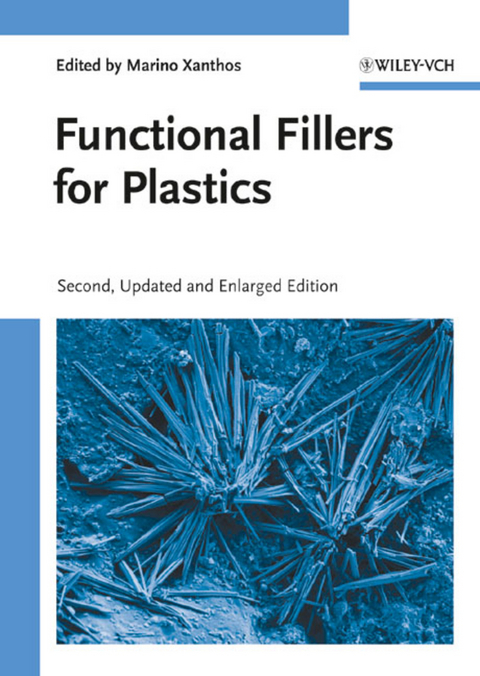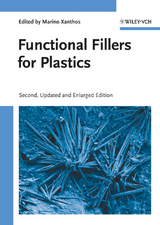Functional Fillers for Plastics
Wiley-VCH (Verlag)
978-3-527-32361-6 (ISBN)
Von international anerkannten Fachleuten aus Industrie und Forschung stammen die Beiträge zu dieser Monographie über Füllstoffe für Plastikmaterialien. Betrachtet werden Herstellung, Struktur, Eigenschaften und Einsatzgebiete der wichtigsten organischen und mineralischen Füllstoffe.
Marino Xanthos is Professor in the Department of Chemical, Biological and Pharmaceutical Engineering at the NJ Institute of Technology (NJIT), Newark, New Jersey since 1995 and served from 1987 to 2005 as Director of Research of the Polymer Processing Institute (PPI), an independent non-profit research organization located at NJIT. He received his PhD and his MD degrees in Chemical Engineering from the University of Toronto and a BSc in Chemistry from the University of Thessaloniki, Greece. He has more than 30 years of academic and industrial experience in directing and conducting research on polymer composites, blends and foams, polymer modification and reactive polymer processing, and plastics-related environmental issues. He is editor/co-author of the books Functional Fillers for Plastics, Reactive Extrusion, and How to Manage Plastic Waste, author/co-author of more than 30 book chapters and 200 publications and holds nine US and Canadian Patents. He is also Executive Editor of the journal Advances in Polymer Technology since 1990, and a Fellow of the Society of Plastics Engineers (SPE).
Preface
PART ONE: Polymers and Fillers
POLYMERS AND POLYMER COMPOSITES
Thermoplastics and Thermosets
Processing of Thermoplastics and Thermosets
Polymer Composites
MODIFICATION OF POLYMER PROPERTIES WITH FUNCTIONAL FILLERS
Introduction
The Importance of the Interface
Modification of Mechanical Properties
Effects of Fillers on Processing Characteristics of Polymers
MIXING OF FILLERS WITH PLASTICS
Introduction
Pretreatment of Fillers
Feeding
Melting
Solids Introduction and Mixing
Venting
Pressure Generation
Process Examples
Further Information
PART TWO: Surface Modifiers and Coupling Agents
SILANE COUPLING AGENTS
Introduction
Production and Structures of Monomeric Silanes
Silane Chemistry
Types of Silanes
Silane Hydrolysis
Reactivity of Silanes Toward the Filler
Combining Silanes and Mineral Fillers
Insights into the Silylated Filler Surfaces
Selection of Silanes
Applications of Specific Silanes
Trends and Developments
TITANATE COUPLING AGENTS
Introduction
The Six Functions of the Titanate Molecule
Summary and Conclusions
FUNCTIONAL POLYMERS AND OTHER MODIFIERS
Introduction
General Types of Modifiers and Their Principal Effects
Modifiers by Chemical Type
PART THREE: Fillers and Their Functions
A - High Aspect Ratio Fillers
GLASS FIBERS
Background
Production Methods
Structure and Properties
Suppliers
Cost/Availability
Environmental/Toxicity Considerations
Applications
Environmental Impact
MIKA FLAKES
Background
Production Methods
Structure and Properties
Suppliers
Cost/Availability
Environmental/Toxicity Considerations
Applications
NANOCLAYS AND THEIR EMERGING MARKETS
Introduction
Production Methods
Structure and Properties
Suppliers
Cost/Availability
Environmental/Toxicity Considerations
Applications
CARBON NANOTUBES/NANOFIBERS AND CARBON FIBERS
Introduction
Materials
Polymer Matrix Composites
Cost/Availability
Environmental/Toxicity Considerations
Applications
B - Low Aspect Ratio Fillers
NATURAL FIBERS
Introduction
Structure and Production Methods
Properties
Suppliers
Cost/Availability
Environmental/Toxicity Considerations
Applications (Primary and Secondary Functions)
TALC
Production Methods
Structure and Properties
Suppliers
Cost/Availability
Environmental/Toxicity Considerations
Applications
KAOLIN
Introduction
Production Methods
Properties
Suppliers
Cost/Availability
Environmental/Toxicity Considerations
Applications
WOLLASTONITE
Introduction
Production
Structure and Properties
Suppliers/Cost
Environmental/Toxicity Considerations
Applications Involving the Plastics Compounding Industry
Summary
Future Considerations for Use of Wollastonite in Plastics
WOOD FLOUR
Introduction
Production Methods
Structure and Properties
Suppliers
Cost/Availability
Environmental/Toxicity Considerations
Applications (Primary and Secondary Functions)
CALCIUM CARBONATE
Background
Production Methods
Structure and Properties
Suppliers
Cost/Availability
Environmental, Toxicity, and Sustainability Considerations
Applications
C - Specialty Fillers
FIRE RETARDANTS
Introduction
Combustion of Polymers and the Combustion Cycle
Fuel
Smoke
Flammability of Polymers
Mechanisms of Fire-Retardant Action
Classification of Flame Retardants
Tools and Testing
Toxicity
Manufacturers of Fire Retardants
Concluding Remarks
CONDUCTIVE AND MAGNETIC FILLERS
Introduction
Carbon Black
Phenomena of Conductivity in Carbon Black-Filled Polymers
Distribution and Dispersion of Carbon Black in Polymers
Other Carbon-Based Conductive Fillers
Intrinsically Conductive Polymers (ICPs)
Metal Particle Composites
Magnetic Fillers
Concluding Remarks
Appendix: Measurement of Resistivity
SURFACE PROPERTY MODIFIERS
Introduction
Solid Lubricants/Tribological Additives
Antiblocking Fillers
PROCESSING AIDS
Introduction
Production
Structure/Properties
Suppliers/Manufacturers
Environmental/Toxicity Considerations
Applications
SPHERICAL FILLERS
Organic Spherical Fillers
Glass and Ceramic Spheres
BIOACTIVE FILLERS
Introduction
Bone as a Biocomposite
Synthetic Biomedical Composites and Their Bioactivity
Bioceramics as Functional Fillers
Modification of Bioceramic Fillers
Fillers Formed In Situ
Recent Developments - Nanostructured Bioactive Fillers
Concluding Remarks
POLYHEDRAL OLILGOMERIC SILSEQUIOXANES
Introduction
Production
Structure and Properties
Suppliers/Cost
Environmental/Safety Considerations
Functions
IN SITU-GENERATED FILLERS: BICONTINUOUS PHASE NANOCOMPOSITES
Introduction
Methodology for the Production of Bicontinuous Nanocomposites
General Properties of Bicontinuous Phase Nanocomposites
Potential Applications of Bicontinuous Nanocomposites
"Das vorliegende Buch gibt einen exzellenten Überblick über die wichtigsten Füllstoffklassen, die in der Kunststoffindustrie zur Anwendung kommen. ... Aufgrund der sehr guten Strukturierung der einzelnen Kapitel eignet sich das Buch vorzüglich als Nachschlagewerk; diese Funktion wird unterstützt durch ein gutes Inhaltsverzeichnis und viele aktuelle Literaturzitate. Aufmachung, Druckbild und die zahlreichen Fotos und Tabellen sind von ausgezeichneter Qualität. Insgesamt ist dieses Buch sehr zu empfehlen."
GAK Gummi Fasern Kunststoffe
"Eine solche Übersicht, wie sie Marino Xanthos mit weiteren Autoren erstellt hat, bringt deshalb Licht in ein vielfach dunkles Feld der Füllstoffe. (...) Eine Vielzahl von fachlichen Anregungen wird über nunmehr bekannte Füllstofffunktionen zu Lösungen von innovativen Aufgaben geboten und sollte der Fachmann zu nutzen wissen."
Klebstoff-Dokumentum
| Erscheint lt. Verlag | 17.2.2010 |
|---|---|
| Sprache | englisch |
| Maße | 170 x 240 mm |
| Gewicht | 1120 g |
| Themenwelt | Naturwissenschaften ► Chemie ► Technische Chemie |
| Schlagworte | Chemie • Chemische Technik • Chemistry • Industrial Chemistry • Kunststoffverarbeitung • Nanomaterialien • nanomaterials • Nanotechnologie • nanotechnology • Polymer processing • Polymer Science & Technology • Polymer Science & Technology • Polymerverarbeitung • Polymerwissenschaft • Polymerwissenschaft u. -technologie • Technische u. Industrielle Chemie |
| ISBN-10 | 3-527-32361-9 / 3527323619 |
| ISBN-13 | 978-3-527-32361-6 / 9783527323616 |
| Zustand | Neuware |
| Haben Sie eine Frage zum Produkt? |
aus dem Bereich




